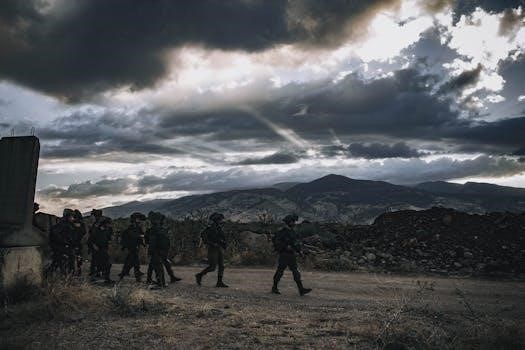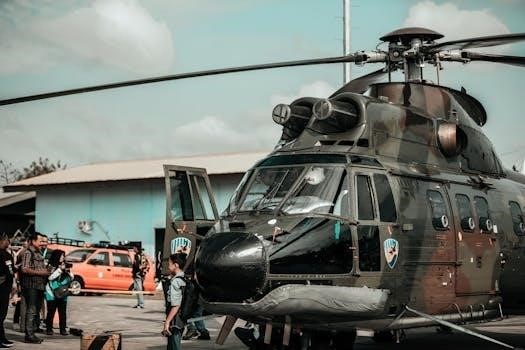Ground guide signals are vital for safe vehicle movement in the Army. These signals‚ primarily hand and arm based‚ ensure clear communication between the guide and the driver‚ promoting safety and preventing accidents during operations.
Importance of Ground Guides
Ground guides are essential for the safe maneuvering of military vehicles‚ acting as the driver’s eyes and ears. They are responsible for guiding vehicles in areas with limited visibility‚ congested spaces‚ or during complex maneuvers. Their role is critical in preventing accidents and ensuring the safety of personnel and equipment. Clear communication through standardized signals between the driver and the ground guide is paramount‚ and their presence directly contributes to mission success.
Basic Ground Guide Principles
Essential principles include using only hand signals to avoid misunderstandings‚ maintaining proper positioning‚ and ensuring seamless coordination between the driver and guide for safe vehicle movement.
Use of Hand Signals Only
The primary method for ground guiding involves the exclusive use of hand and arm signals. Voice commands can be easily misinterpreted or unheard‚ especially in noisy environments. Therefore‚ standardized hand signals provide clear‚ concise instructions‚ ensuring the driver understands the guide’s directions. These signals are the cornerstone of effective and safe ground guiding operations‚ promoting clear communication in all situations. This method ensures there is no room for misinterpretation.
Ground Guide Positioning
Proper positioning of the ground guide is crucial for effective signaling and safety. The guide must be in a location where the driver can see them clearly at all times. The ground guide should face the vehicle they are directing‚ and should never be positioned between the vehicle and any other objects‚ preventing potential injury in case of accidental movement. If there are multiple guides‚ only the guide facing the vehicle will give signals to the driver directly.
Coordination Between Driver and Guide
Effective ground guiding relies heavily on the coordination between the driver and the ground guide. Prior to any vehicle movement‚ both individuals must understand the established hand signals and procedures. If the driver loses sight of the guide at any point‚ they must immediately stop the vehicle. Clear communication ensures smooth and safe maneuvering‚ minimizing the risk of incidents. Both driver and guide should be on the same page.
Types of Ground Guide Signals
Ground guide signals primarily consist of daytime hand and arm signals. Night operations utilize screened flashlights or chem-lights to maintain effective communication in limited visibility conditions.
Daytime Hand and Arm Signals
Daytime ground guide signals rely heavily on distinct hand and arm movements. These include directional signals‚ speed control signals‚ and stop signals. The ground guide uses one hand to give signals‚ keeping the other motionless. Clear and precise movements are essential for the driver to understand the instructions‚ ensuring the vehicle is maneuvered safely. These signals are the primary method of communication during daylight operations‚ as voice can be easily misunderstood.
Nighttime Signals (Screened Flashlights/Chem-lights)
In low-light or nighttime conditions‚ screened flashlights or chem-lights are used to communicate ground guide signals. The movements made with these light sources mimic daytime hand and arm signals. The use of screened flashlights is the best method for ground guiding vehicles at night. It is crucial that the light is filtered or screened to avoid blinding the driver and ensuring effective communication. The same clear understanding of signals applies.
Specific Ground Guide Signals
Specific ground guide signals include directional‚ speed control‚ and stop signals. These hand and arm movements are standardized to ensure clear and consistent communication between the ground guide and the vehicle driver.
Directional Signals
Directional signals in ground guiding use specific hand and arm movements to indicate the direction the driver should steer the vehicle. For instance‚ pointing an arm in the desired direction indicates which way to turn the wheels; shaking the hand indicates more of a turn‚ and stopping the hand indicates to stop turning. These signals are crucial for precise vehicle maneuvering.
Speed Control Signals
Speed control signals are essential for managing the vehicle’s pace during ground guiding. A fist held out with the thumb up typically indicates a ‘slow’ command‚ prompting the driver to reduce speed. These signals help maintain a safe and controlled movement‚ particularly in congested or sensitive areas‚ ensuring the vehicle moves at the appropriate rate directed by the ground guide.
Stop Signals
The ‘stop’ signal is a critical command in ground guiding. It is usually indicated by extending both arms with palms down‚ or sometimes by placing palms down on top of the helmet. This signal immediately instructs the driver to halt the vehicle‚ preventing potential collisions or mishaps. The clear execution of the stop signal is paramount for safety‚ especially when maneuvering in tight spaces or near obstacles.

Other Visual Signals
Beyond hand signals‚ the Army employs flag signals‚ pyrotechnic signals‚ and ground-to-air signals. These methods provide additional communication options for various operational needs and environments‚ enhancing overall effectiveness.
Flag Signals
Flag signals serve as an extension of hand and arm signals‚ used in a similar manner to direct vehicle movement. These are particularly useful in situations where distance or visibility may impede clear hand signal communication. Flags can convey directional commands‚ speed adjustments‚ or the need to stop‚ ensuring clear visual cues for the driver‚ and are an important part of the overall signaling system. They provide a more visible alternative in certain conditions.
Pyrotechnic Signals
Pyrotechnic signals are employed to communicate with an entire unit‚ either when mounted or dismounted. These signals are used for broader communication‚ often to convey information across a larger area. Unlike hand signals for individual vehicles‚ pyrotechnics can signal general orders‚ status changes or warnings. They offer a means to rapidly and visibly communicate to many personnel simultaneously‚ ensuring coordinated actions across a unit or large formation in various operational situations.
Ground-to-Air Signals
Ground-to-air signals are crucial for guiding helicopters to designated landing zones. These signals use visual aids and systems to communicate with aircraft from the ground‚ often employing hand and arm signals‚ devices or emergency codes. They enable ground forces to direct helicopters for resupply‚ troop transport or medical evacuations‚ ensuring the safe and efficient execution of air operations. Proper implementation is essential for effective coordination between ground and air assets during military operations.

Safety Considerations
Safety is paramount; ground guides must avoid blind spots and never walk backwards. Proper positioning prevents accidents. An inadvertent engine surge can cause injury‚ so awareness is key.
Avoiding Blind Spots
Ground guides must be acutely aware of vehicle blind spots. Positioning themselves where the driver can always see them is crucial. If the driver loses sight of the guide‚ the vehicle must immediately stop. Understanding the limitations of the driver’s vision ensures the guide’s safety and effective vehicle maneuvering. Never stand in a position where a vehicle could crush you against an object.
Prohibition of Walking Backwards
A fundamental safety rule for ground guides is to never walk backwards while directing a vehicle. This practice significantly increases the risk of falls‚ collisions with unseen objects‚ or being run over. Maintaining a forward-facing position allows the guide to observe the surroundings and react appropriately to any potential hazards‚ ensuring their safety and the safe operation of the vehicle.

Documentation and Standards
The U.S. Army’s ground guide procedures are documented in publications like FM 21-60 and TC 3-21.60. USAREUR Regulation 385-55 also provides standards‚ ensuring consistent application of these signals.
FM 21-60 and TC 3-21.60 References
FM 21-60 is a foundational manual that details the basic hand and arm signals used for ground guiding military vehicles. These signals are crucial for effective communication between drivers and ground guides. The more recent TC 3-21.60 updates and expands upon these standards‚ providing the most current and standardized visual signals for various ground guiding scenarios‚ ensuring clarity and safety during operations and training exercises.
USAREUR Regulation 385-55
USAREUR Regulation 385-55 provides specific ground-guiding standards within the United States Army Europe. This regulation emphasizes the importance of adherence to the arm-and-hand signals detailed in FM 21-60 to prevent accidents and ensure the safety of personnel. It reinforces that ground guides must not position themselves between the vehicle and other objects‚ highlighting the need for cautious and deliberate guidance to avoid potential injury or fatalities.

Ground Guide Training
Ground guide training is crucial‚ emphasizing standardized signals. This training ensures both drivers and guides understand their roles‚ promoting safe vehicle operations and minimizing risks during maneuvers.
Driver Training Curriculum
The driver training curriculum incorporates ground guide signal understanding‚ emphasizing the importance of visual communication. Drivers learn to recognize and respond to standard hand and arm signals‚ ensuring safe vehicle operation. A driver must always maintain sight of the guide; if visual contact is lost‚ the driver must stop immediately until contact is re-established. This training is critical for accident prevention and mission success. Drivers must coordinate with ground guides before any operation.
Importance of Standardized Signals
Standardized signals are crucial for effective ground guiding‚ ensuring all personnel understand the same commands. The use of consistent hand and arm signals‚ as prescribed in FM 21-60 and TC 3-21.60‚ eliminates confusion and potential errors. This standardization is essential for the safety of personnel and equipment during vehicle movements‚ especially in congested or high-risk environments. Consistent signals allow for seamless coordination across different units and locations‚ improving overall operational efficiency.
Application in Different Scenarios
Ground guide signals are adapted for various situations‚ including congested areas and guiding vehicles into aircraft. These signals ensure safe and precise vehicle maneuvering in diverse operational settings‚ crucial for mission success.
Ground Guiding in Congested Areas
In congested areas‚ ground guides are crucial for safe vehicle operation. They must be positioned to provide maximum visibility‚ often at the front and rear of the vehicle. Clear communication through standardized signals‚ like hand and arm motions‚ is essential to prevent accidents and ensure smooth maneuvering. The ground guides become the eyes and ears of the driver in these complex environments‚ guaranteeing the safety of all personnel involved during vehicle movements.
Guiding Vehicles into Aircraft
Guiding vehicles into aircraft requires precise ground guide signals to ensure safe loading and unloading. Soldiers utilize specific hand and arm signals to direct vehicles into the cargo bay‚ often in confined spaces. This process demands clear communication and coordination between the guide and the driver. The use of standardized signals‚ like directional and stop signals‚ is essential for preventing damage to the aircraft and ensuring personnel safety during these operations.
Ground Guide Signals in Other Military Branches
Other military branches often adapt the Army’s ground guide signals. These adaptations ensure interoperability‚ using similar hand and arm signals for consistent vehicle movement guidance across different forces.
Adaptation of Army Signals
While the Army establishes a foundation for ground guide signals‚ other branches often adapt them to suit their unique operational needs and equipment. These adaptations maintain a core consistency but incorporate specific nuances or variations. This ensures clear communication between different military elements while facilitating interoperability. Such adaptations highlight the importance of standardization across forces‚ whilst allowing for necessary flexibility in diverse situations. These modified signals ensure clarity and safety during joint operations involving different services.